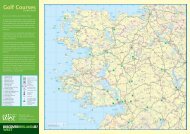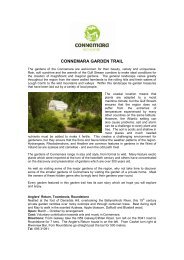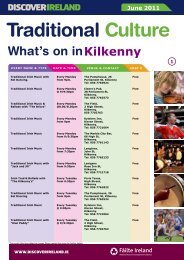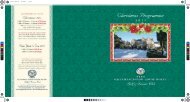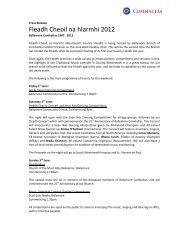Free Guide - Discover Ireland
Free Guide - Discover Ireland
Free Guide - Discover Ireland
Create successful ePaper yourself
Turn your PDF publications into a flip-book with our unique Google optimized e-Paper software.
Trim<br />
Trim contains more Medieval buildings<br />
than any town in <strong>Ireland</strong><br />
Trim is situated on the banks of the River Boyne in an area of fertile<br />
plains. The town developed around Trim Castle, straddling the river<br />
to the north and west of the castle. In the 13th century the town was<br />
enclosed within a circuit of stone walls. Augustinian (1202), Franciscan<br />
(1260), and Dominican (1263) friaries were established, indicating<br />
the growing prosperity of the town. In the later medieval period Trim<br />
became an increasingly exposed frontier, standing between the hostile<br />
worlds of the Anglo-Normans and the Gaelic Irish.<br />
Aside from Trim Castle, which dominates<br />
the town, the fragments of the medieval<br />
town are still clearly visible. The wall which<br />
circled the settlement is visible in part, mainly<br />
around Castle St. and Emmet St. west of the<br />
castle. The Sheep Gate is the only surviving of<br />
several medieval gateways to the town. The<br />
jagged Yellow Steeple was formerly a sevenstoried<br />
church tower belonging to St Mary’s<br />
Augustinian Abbey, it gets its name from<br />
the colour of the stonework in the evening<br />
sun. St Patrick’s Church (Church of <strong>Ireland</strong>)<br />
is primarily a 19th century structure, though<br />
with medieval remains.<br />
The tower on its west face incorporates<br />
the arms of Richard, Duke of York, Lord<br />
of Trim and Viceroy in <strong>Ireland</strong> from 1449.<br />
Interestingly, <strong>Ireland</strong>’s oldest complete and<br />
30 FOR MORE INFORMATION GO TO WWW.DISCOVERIRELAND.IE/BOYNEVALLEY<br />
unaltered bridge (dating from 1393) crosses<br />
the Boyne at Trim.<br />
A few kilometres downstream of Trim stand<br />
the ruins of Newtown Trim – a large medieval<br />
cathedral, two monasteries and a small<br />
church. These ruins symbolise the failed<br />
attempt by the first English Bishop of Meath,<br />
Simon de Rochfort, to establish a rival town to<br />
de Lacy’s Trim.<br />
During the early 1700s Jonathan Swift, author<br />
of Gulliver’s Travels, lived at Lacacor, near<br />
Trim, where he served as vicar to a small<br />
congregation. Arthur Wellesey, better known<br />
as the Duke of Wellington or ‘the Iron Duke’,<br />
was educated at Trim and spent much of<br />
his childhood at the nearby Dangan Castle,<br />
his father’s country house (now in ruins). He







